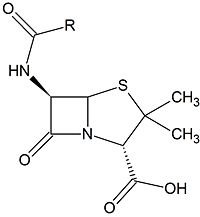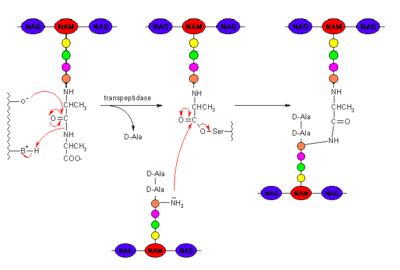Sandbox Reserved 988
From Proteopedia
| (One intermediate revision not shown.) | |||
| Line 8: | Line 8: | ||
[[Image:Beta-lactam.jpg|200px|thumb|right|A [http://en.m.wikipedia.org/wiki/Beta-lactam_antibiotic β-lactam antibiotic] ([http://en.m.wikipedia.org/wiki/Penicillin Penicillin])]]Clinically, [http://en.m.wikipedia.org/wiki/Beta-lactam_antibiotic β-lactam antibiotics], characterized by their central four-membered cyclic amide, are utilized to combat various bacterial infections. This antibiotic class targets [http://proteopedia.org/wiki/index.php/Penicillin-binding_protein penicillin-binding proteins] (PBPs), also known as [http://en.m.wikipedia.org/wiki/DD-transpeptidase transpeptidase enzymes]. PBPs are enzymes that catalyze [http://en.wikipedia.org/wiki/Cross-link cross-linking] between strands of the [http://en.m.wikipedia.org/wiki/Peptidoglycan peptidoglycan] layer of the bacterial cell wall. <ref>"Peptidoglycan cell wall." The University of Warwick. n.d. Web. 25 Jan 15</ref> This cross-linking process strengthens the cell wall and enables the bacteria to resist [http://en.wikipedia.org/wiki/Osmotic_pressure osmotic pressure] from its external environment. | [[Image:Beta-lactam.jpg|200px|thumb|right|A [http://en.m.wikipedia.org/wiki/Beta-lactam_antibiotic β-lactam antibiotic] ([http://en.m.wikipedia.org/wiki/Penicillin Penicillin])]]Clinically, [http://en.m.wikipedia.org/wiki/Beta-lactam_antibiotic β-lactam antibiotics], characterized by their central four-membered cyclic amide, are utilized to combat various bacterial infections. This antibiotic class targets [http://proteopedia.org/wiki/index.php/Penicillin-binding_protein penicillin-binding proteins] (PBPs), also known as [http://en.m.wikipedia.org/wiki/DD-transpeptidase transpeptidase enzymes]. PBPs are enzymes that catalyze [http://en.wikipedia.org/wiki/Cross-link cross-linking] between strands of the [http://en.m.wikipedia.org/wiki/Peptidoglycan peptidoglycan] layer of the bacterial cell wall. <ref>"Peptidoglycan cell wall." The University of Warwick. n.d. Web. 25 Jan 15</ref> This cross-linking process strengthens the cell wall and enables the bacteria to resist [http://en.wikipedia.org/wiki/Osmotic_pressure osmotic pressure] from its external environment. | ||
| - | [[Image:Peptidoglycan_cross_linking.png|400px|thumb| | + | [[Image:Peptidoglycan_cross_linking.png|400px|thumb|left|Peptidoglycan with PBP Cross-linking Mechanism]] |
| - | β-lactam antibiotics covalently link to PBPs, [http://en.m.wikipedia.org/wiki/Enzyme_inhibitor inhibiting] them from cross-linking the peptidoglycan layer of the cell wall. | + | β-lactam antibiotics covalently link to PBPs, [http://en.m.wikipedia.org/wiki/Enzyme_inhibitor inhibiting] them from cross-linking the peptidoglycan layer of the cell wall. The irreversible binding of the β-lactam antibiotic renders the PBP incapable of its catalytic function. This results in death of bacterial cells from osmotic instability or [http://en.m.wikipedia.org/wiki/Autolysis_(biology) autolysis].<ref name="MSUDP 2014"> |
Beta Lactam Antibiotics, 2011. Antimicrobial Resistance Learning Site. Michigan State University Department of Pharmacology. 16 Sept, 2014. | Beta Lactam Antibiotics, 2011. Antimicrobial Resistance Learning Site. Michigan State University Department of Pharmacology. 16 Sept, 2014. | ||
</ref> | </ref> | ||
| - | One of the main causes of [http://en.wikipedia.org/wiki/Antimicrobial_resistance resistance] to β-lactam antibiotics is caused by β-lactamase enzymes. Chemically, β-lactamases and PBPs bind to β-lactam antibiotics in similar mechanisms. The catalytic serine of both enzymes performs a nucleophilic attack on to the carbonyl group in the β-lactam functional group of the antibiotic. | + | One of the main causes of [http://en.wikipedia.org/wiki/Antimicrobial_resistance resistance] to β-lactam antibiotics is caused by β-lactamase enzymes. Chemically, β-lactamases and PBPs bind to β-lactam antibiotics in similar mechanisms. The catalytic serine of both enzymes performs a nucleophilic attack on to the carbonyl group in the β-lactam functional group of the antibiotic. Unlike PBPs, where the β-lactam antibiotics bind irreversibly, β-lactamases are able to undergo [http://en.m.wikipedia.org/wiki/Acetylation deacylation] in order to regenerate their active site. This process cleaves the β-lactam ring, ridding the β-lactam antibiotic of its antimicrobial activity. <ref>Powers, Rachel, Hollister C. Swanson, Magdalena A. Taracila, Nicholas W. Florek, Chiara Romagnoli, Emilia Caselli, Fabio Prati, Robert A. Bonomo, and Bradley J. Wallar. Biochemical and Structural Analysis of Inhibitors Targeting the ADC-7 Cephalosporinase of Acinetobacter baumannii. Biochemistry, 2014, 53 (48), 7670-7679.</ref> The cleaved β-lactam antibiotic is unable to inhibit PBPs, allowing cross-linking to occur for adequate cell wall formation. |
Current revision
| This Sandbox is Reserved from 20/01/2015, through 30/04/2016 for use in the course "CHM 463" taught by Mary Karpen at the Grand Valley State University. This reservation includes Sandbox Reserved 987 through Sandbox Reserved 996. |
To get started:
More help: Help:Editing |
Contents |
Your Heading Here (maybe something like 'Structure')
This is a default text for your page '. Click above on edit this page' to modify. Be careful with the < and > signs. You may include any references to papers as in: the use of JSmol in Proteopedia [1] or to the article describing Jmol [2] to the rescue.
Background
Clinically, β-lactam antibiotics, characterized by their central four-membered cyclic amide, are utilized to combat various bacterial infections. This antibiotic class targets penicillin-binding proteins (PBPs), also known as transpeptidase enzymes. PBPs are enzymes that catalyze cross-linking between strands of the peptidoglycan layer of the bacterial cell wall. [3] This cross-linking process strengthens the cell wall and enables the bacteria to resist osmotic pressure from its external environment.β-lactam antibiotics covalently link to PBPs, inhibiting them from cross-linking the peptidoglycan layer of the cell wall. The irreversible binding of the β-lactam antibiotic renders the PBP incapable of its catalytic function. This results in death of bacterial cells from osmotic instability or autolysis.[4]
One of the main causes of resistance to β-lactam antibiotics is caused by β-lactamase enzymes. Chemically, β-lactamases and PBPs bind to β-lactam antibiotics in similar mechanisms. The catalytic serine of both enzymes performs a nucleophilic attack on to the carbonyl group in the β-lactam functional group of the antibiotic. Unlike PBPs, where the β-lactam antibiotics bind irreversibly, β-lactamases are able to undergo deacylation in order to regenerate their active site. This process cleaves the β-lactam ring, ridding the β-lactam antibiotic of its antimicrobial activity. [5] The cleaved β-lactam antibiotic is unable to inhibit PBPs, allowing cross-linking to occur for adequate cell wall formation.
History
Many medical textbooks recount Alexander Flemming’s serendipitous observation of the antibacterial action of Penicillium mold in 1928. While not the first to note the inhibitory effect, Flemming became the first to seriously push the scientific community to research the isolation of the active compound, which he named penicillin. Eventually these efforts paid off and in 1940, Sir Ernst Boris Chain published a method of isolating and purifying penicillin and tested its clinical effectiveness in mice. Later that year, he identified the first β-lactamase in Escherichia coli. While interesting, this discovery was not considered clinically relevant until β-lactamase enzymes were isolated from clinical samples of gram positive bacteria by Dr. William M. M. Kirby.
| |||||||||||
Disease
Placeholder
References
- ↑ Hanson, R. M., Prilusky, J., Renjian, Z., Nakane, T. and Sussman, J. L. (2013), JSmol and the Next-Generation Web-Based Representation of 3D Molecular Structure as Applied to Proteopedia. Isr. J. Chem., 53:207-216. doi:http://dx.doi.org/10.1002/ijch.201300024
- ↑ Herraez A. Biomolecules in the computer: Jmol to the rescue. Biochem Mol Biol Educ. 2006 Jul;34(4):255-61. doi: 10.1002/bmb.2006.494034042644. PMID:21638687 doi:10.1002/bmb.2006.494034042644
- ↑ "Peptidoglycan cell wall." The University of Warwick. n.d. Web. 25 Jan 15
- ↑ Beta Lactam Antibiotics, 2011. Antimicrobial Resistance Learning Site. Michigan State University Department of Pharmacology. 16 Sept, 2014.
- ↑ Powers, Rachel, Hollister C. Swanson, Magdalena A. Taracila, Nicholas W. Florek, Chiara Romagnoli, Emilia Caselli, Fabio Prati, Robert A. Bonomo, and Bradley J. Wallar. Biochemical and Structural Analysis of Inhibitors Targeting the ADC-7 Cephalosporinase of Acinetobacter baumannii. Biochemistry, 2014, 53 (48), 7670-7679.


